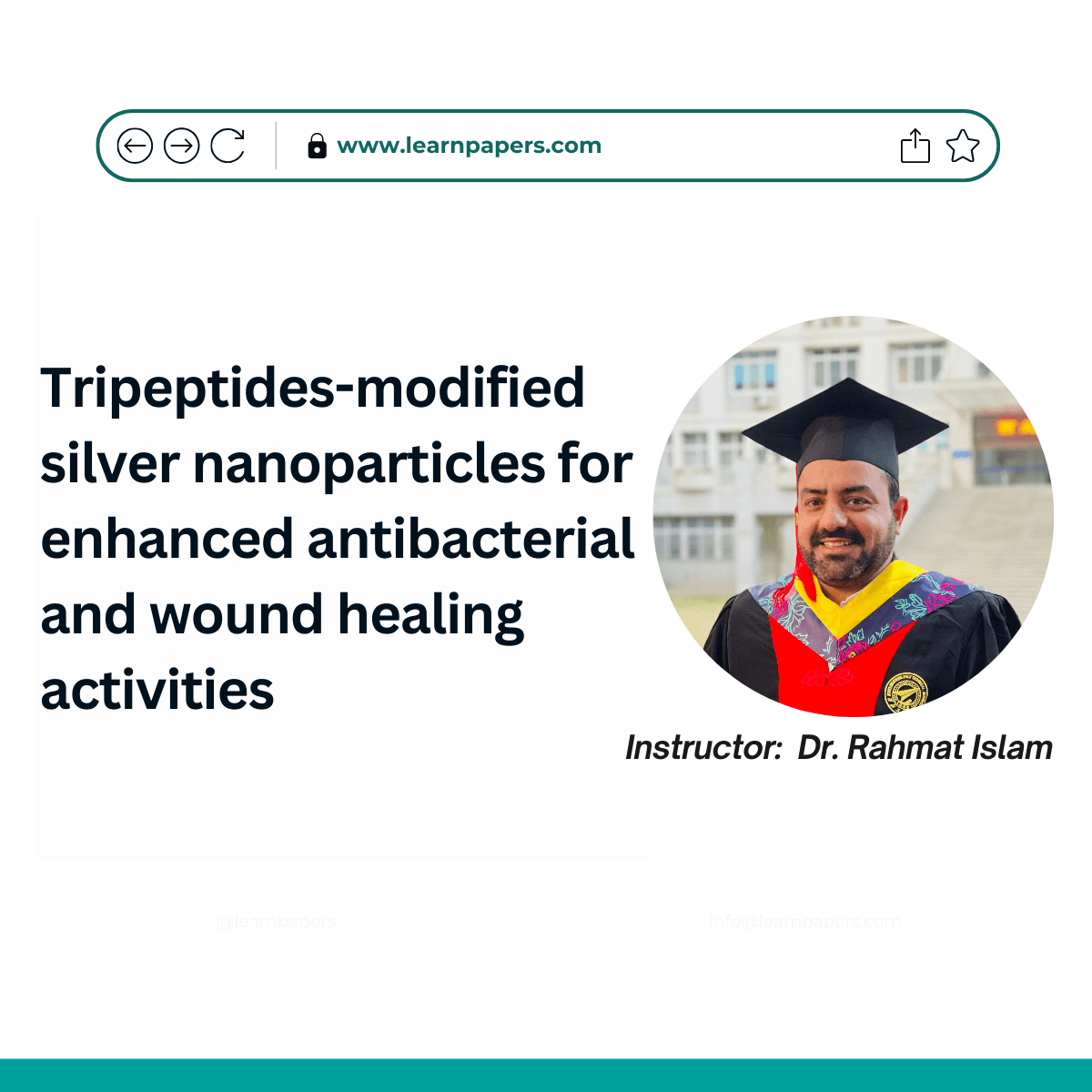Tripeptides-Modified Silver Nanoparticles for Enhanced Antibacterial and Wound Healing Activities

About Course
The course “Tripeptides-Modified Silver Nanoparticles for Enhanced Antibacterial and Wound Healing Activities” explores an innovative approach to biomedical applications, combining nanotechnology with peptide engineering. Silver nanoparticles (AgNPs) have long been recognized for their antibacterial properties, but recent advancements in peptide modifications have further enhanced their effectiveness. This course delves into the design, synthesis, and functionalization of tripeptide-modified AgNPs, demonstrating their improved antibacterial potential and wound healing capabilities. Learners will gain insights into the underlying mechanisms, experimental methodologies, and potential real-world applications of these advanced nanomaterials in medical science.
Designed for researchers, students, and professionals in nanotechnology, pharmaceuticals, and biomedical sciences, this course provides a comprehensive understanding of how peptide-functionalized nanoparticles can revolutionize infection control and tissue regeneration. Participants will explore key concepts in nanoparticle synthesis, biocompatibility assessments, and in-vitro and in-vivo testing procedures. By the end of the course, learners will be equipped with practical knowledge to apply these cutting-edge techniques in their own research or professional projects, bridging the gap between theoretical science and clinical applications.
Abstract
Bacterial skin infections represent a major healthcare concern that can delay healing and threaten human health. Silver nanoparticles (AgNPs) have been widely used for antimicrobial purposes; however, their high toxicity limits their applications. Therefore, there is an urgent need to develop simple and efficient therapeutic approaches for treating bacterial infections and promoting wound healing. Here, novel tripeptide (Ghk and GhkCu)-modified AgNPs were developed and subsequently evaluated their antibacterial efficacy against four pathogenic bacterial isolates, cytotoxic properties, and therapeutic effects as a topical treatment for infected wounds. Spherical GhkAgNPs and GhkCuAgNPs with average sizes of 45.92 nm and 56.82 nm exhibited potential antibacterial activity, with a MIC concentration of 8 μg/ml against S. aureus and E. coli. Both AgNPs showed superior bactericidal effects against S. aureus, with complete inhibition after 7 days of treatment. Cytotoxicity assays revealed IC50 (half maximal inhibitory concentrations) values ranging from 6.75 to 6.99 µg/ml in L929 cells. GhkAgNPs displayed accelerated cell migration and facilitated healing up to 92% after 12 h. Furthermore, topical applications of GhkAgNPs and GhkCuAgNPs to S. aureus-infected wounds demonstrated enhanced in vivo wound healing efficacy compared to control groups, as evidenced by increased regenerated epidermal thickness, improved collagen deposition, and downregulation of TNF-α expression. Hence concluded that these novel tripeptides Ghk and GhkCu-modified AgNPs exhibited potent antibacterial effects and significantly promoted wound healing properties.
What Will You Learn?
- By enrolling in this course, you will gain detailed and in-depth knowledge on the following topics:
- (A) Understand the Challenges of Wound Healing and Bacterial Infections
- (B) The Role of Peptides in Biomedical Applications
- (C) Synthesis and Characterization of Tripeptides-Modified Nanoparticles
- (D) Antimicrobial Susceptibility Testing Techniques
- (E) Cytotoxicity and Biocompatibility Experimental Setup and Analysis
- (F) In Vivo and In Vitro Wound Healing Procedures
- (G) Validation of Research Findings
Course Content
Module 1: Introduction to Bacterial Infections and Wound Healing Challenges
• Overview of bacterial skin infections and their global impact.
• Traditional treatments and their limitations.
• Introduction to nanotechnology in wound healing.
Module 2: Role of Tripeptides in Wound Healing
• Properties of Ghk and GhkCu peptides.
• Antibacterial and anti-inflammatory mechanisms of tripeptides.
Module 3: Synthesis of Tripeptides-Modified Metal Nanoparticles
• Step-by-step synthesis process using hydrothermal methods.
• Physicochemical characterization techniques: TEM, FTIR, and XPS.
Module 4: Evaluation of Antibacterial Activity
• In vitro antibacterial activity testing against E. coli, S. aureus, and other pathogens.
• MIC and MBC determination and comparative studies.
Module 5: Cytotoxicity and Biocompatibility Testing
• Cytotoxicity evaluation using CCK-8 assay.
• Stability and hemocompatibility assessments of AgNPs.
Module 6: In Vivo Wound Healing Applications
• Experimental setup for S. aureus-infected wound healing.
• Key findings: enhanced healing rates, collagen deposition, and reduced inflammation.
Module 7: Research Validation Studies
• Histological analysis of treated wounds.
• TNF-α expression and its role in healing processes.
• Validation of results through comparison with control groups.
Module 8: Future Directions and Medical Applications
• Limitations and safety concerns of long-term AgNP exposure.
• Potential applications in biofilms and drug-resistant bacterial treatments.
• Directions for future research in nanotechnology-based therapies.
Student Ratings & Reviews
